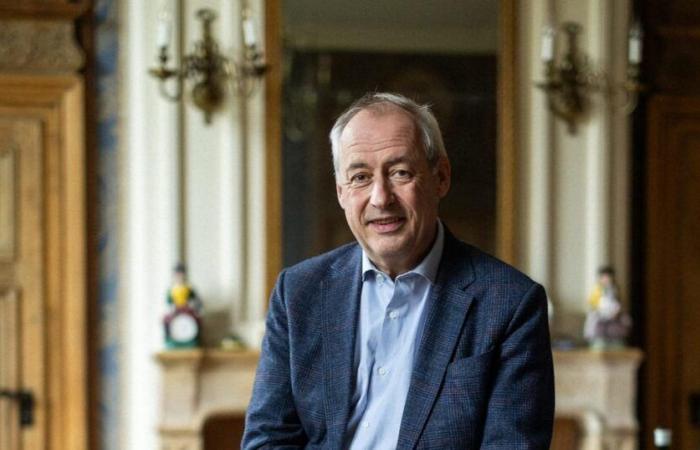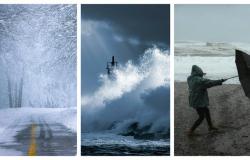
As the high mass of the Hospices de Beaune sale looms and the return of Donald Trump at the helm in the United States, where Burgundy exports more than 20% of its wines, take stock of the situation with Albéric Bichot, at the head from Domaines Albert Bichot.
Coming from a long Burgundian lineage, Albéric Bichot has managed Domaines Albert Bichot for almost 30 years. For 25 years, Maison Albert Bichot has been the first buyer of the Hospices de Beaune sale, the 164th edition of which will take place this Sunday, November 17.
Republicans or Democrats? Did you have a preference for these American elections?
No, honestly, we don't do politics. We are trying to see what is good for French viticulture. Afterwards we take note. Now, we will have to appoint our European commissioners, since we have been waiting for them for so long. And Europe will have to be able to open interesting negotiations with the new North American administration.
Can we say to date whether the result of the North American elections is good or bad news for the affairs of Burgundy?
The American market is still the main market for Burgundy. It's historic. Today, 23% of Burgundy's exports go to the United States. Now what will happen next spring? Is the new president really going to put taxes on all European products… We're not going to shout until it hurts.
I imagine that collectively, you foresee all the possibilities?
I believe everything is possible. Apparently Donald Trump has never hidden it, like Kamala Harris. It’s surely legitimate for their country, it’s “America first” anyway. A discussion between the United States and Europe must take place. Should Europe choose sides between the United States and China? It is a game with at least 3 cushions. But I am not Minister of Foreign Trade or the Economy.
Can we say that geopolitics is an obstacle to commercial activity in Burgundy today? And of the Bichot house in particular?
Customs barriers, taxes, currency rates… These are important environments. Of course, that plays a big role. Some countries practice more or less protectionist policies like India and China, if we take into account what is happening at the moment. All of this still has an impact on business, of course. And then Burgundy, we know, it's not just the grands crus, it's also Mâcon-Villages, it's Chablis, it's red Burgundy, it's a whole. All wines are affected. For example, the United States is one of the largest importers of Crémant de Bourgogne, Mâcon, Beaujolais-Villages, Pouilly-Fuissé… And when there are price fluctuations of 10, 15 or 20% due to taxes, inevitably this has repercussions. During the conflict between Boeing and Airbus which opposed us to the United States, there were taxes for almost 3 years of 25% on all wines imported from France. The figures had fallen for all wine producers in the US market by around 25% in value.
Today, we still have the impression that Burgundy is doing better than other vineyards which are experiencing serious crises. Do you share this feeling?
Yes, but without boasting. We are not here to show off or be smart. We will say that Burgundy has been stable over the last 18 months, which is rather good news. The profile of our wines, whether pinot noir or chardonnay, corresponds to the expectations of consumers today. But let's remain vigilant. And reasonable.
The whole world wants to drink Burgundies, the demand has expanded, and the supply is not so plentiful. So everything should be fine, right?
That's what we hope. I am very measured and reasonable because you must not boast, you must be lucid and pragmatic, that's all. Certainly, Burgundy produces 1,700,000 hectoliters per year, on average. So indeed, it is very small and this is one of the keys to our success. But let's not rest on our laurels. And then we have to prepare for the future. The expected harvest in 2024 in terms of volume is perhaps the smallest harvest we have seen in decades. Where are we going with all this? What are our stock levels? There is a lot to do and now is not the time to get back into an inflationary cycle, in my opinion.
Consumption patterns are changing. How to adapt? It is still a matter of convincing young people that wine is not bad for your health, in small doses, and that it can trigger very pleasant moments…
It's super important. And whether in France or elsewhere. I was in the United States 2 weeks ago, it was clearly explained to me that in the recreational budget of consumers, even those aged 35-45, there is wine, spirits, cocktails and then there is the recreational that is smoked or taken in tablets. And one of the competitors, among others, of wine in the United States, even in Canada, is narcotics. And this since in the United States, almost in all states, all this is kindly authorized. Wallets have a certain size. And when you have to arbitrate “for recreational purposes” as they call it, the wine world can get scared.
There is also the development of alcohol-free products which is a real phenomenon. Does Burgundy need to develop an alcohol-free wine offering?
If tomorrow I make a non-alcoholic Pommard, it will no longer be called Pommard and it will no longer be called Burgundy. It's called alcohol-free wine, that's all. So why go and ruin my Pommard to make a non-alcoholic wine that will also resemble anything but Pommard? I think there are other regions in France or in Europe where they can really ask themselves the question because they need to resolve market problems, but Burgundy is not there yet.
This year, the Hospices de Beaune estate presents its first certified organic vintage. Is organic essential today?
Yes. I would say that the imperative, in Burgundy as elsewhere, but perhaps more in Burgundy than elsewhere, is to protect our DNA, to protect our soil and our subsoil. If we think that being organic can preserve soils and subsoils and that we can do it from an economic point of view and from a technical point of view and that we also have the deep conviction of this, yes , it must be done. This must be done within reasonable limits. What happened this year in France and particularly in Burgundy, the invasion of mildew, etc., risks undermining certain organic practices. This is one of the risks, especially with the organic regulations we have today. If we stop organic farming, even just one plot or two plots, the entire estate can no longer be claimed as organic and must go back for 3 years of reconversion. There are perhaps avenues for relaxation or understanding to be found for the organic label in general if we really want to collectively continue to move in this direction.
But you can't be organic when the weather is nice and stop when the weather conditions deteriorate.
That's for sure. We have been organic for a lot of years. We stayed organic all year, we didn't change anything, we accept it. But there are perhaps things to review, at the national level if we want to push towards organic. We can produce a yield of between 5 and 10 hectares per hectare once, but not twice and certainly not 3 times. And then growing organic in our Burgundian latitudes is often more complicated than on the Côte d'Azur.
Also read
Why the return of Donald Trump is giving the French wine industry a cold sweat
The sale of Hospices has evolved significantly in recent years. It has visibly globalized…
It continued its globalization which had been underway for a long time. We will say since 2005, with Christie's, with the fact of being able to buy piece by piece and no longer just complete lots. Hospices also followed the internationalization of Burgundy sales.
How will this Hospices de Beaune sale evolve? Always more media, always more attractive, with ever more expensive wines?
More expensive, I don't know. What we know is that there are 440 and a half pieces instead of 752 I think last year. It’s still -40% on average volume. If our friends, our aficionados, our collectors are still hanging on this year, there is a risk of a fight. We are in a context where the prices of wines in general, Burgundies in particular, and Hospices de Beaune even more, are already at historically high levels. When I see the panorama of all our different buyers, whether French, Asian or American, they all have relatively similar motivations. That is to say, they love Burgundy, they love great wines and especially the somewhat exclusive side of the Hospices de Beaune. Plus you have your name on the label. They participate in writing their history and the history of the Hospices at the same time. Especially since we see that it is still a particular clientele who are interested in sales. The wines are already at a certain price. But we are talking about 440 pieces. All you need is 200 buyers on the planet who each buy 2 pieces and the sale is over.
Is there a piece in particular that you will covet during the November 17 sale?
There are batches that we follow because we know the vines well, because they correspond to taste and quality criteria that suit us well. Last year, for example, we bought almost all of the Clos de la Roche, all of the Échezeaux. It turns out that there are 3 times less than last year, so we will have to look for other wines or wait until next year. The biggest batch of grands crus at the Hospices de Beaune sale is the Mazys-Chambertin grand cru. This year, there are 7 pieces for sale. Last year, there were 25. It's crazy and it's obviously worrying. The hospital will recover, but at an average price of 134,000 euros per piece last year, with a deficit of 18 pieces, the calculation is quickly done. That’s 2,300,000 euros that won’t go to the hospital. Life is like that. Our first motivation is the hospital, it is to receive our great friends, collectors and enthusiasts from all over the world during this weekend and to share in Burgundian style. That's what it's all about.
”
data-script=”https://static.lefigaro.fr/widget-video/short-ttl/video/index.js”
>





